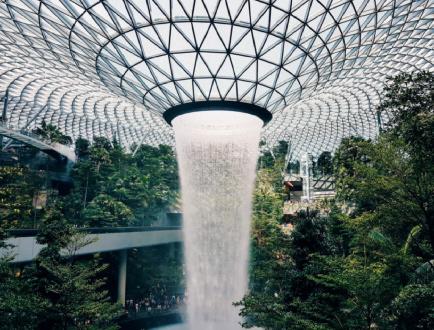
4 minute read
WORKIN’ ON THE RAILS
WORKIN’ ON THE RAILS The Canberra light rail infrastructure gets an aesthetic upgrade to forge visual appeal as it serves the city’s populace
With a plan to provide increased moveability for the burgeoning population in Australia’s capital, the Canberra light rail network, known as the Canberra Metro (the Metro), was launched in 2018. Seeking to service a predicted population of around 500,000 by 2030, the light rail is a signifi cant infrastructure project undertaken by the ACT Government with high visibility — both fi guratively and literally.
Designed to support an integrated public transport system, the Metro connects populated areas with employment centres and social and cultural hubs across the city. Part of a network that links buses, park-and-ride facilities and key transport interchanges, the Metro will help relieve urban congestion and enhance liveability for Canberrans and visitors to the city.


The fi rst stage of the project, a 12-kilometre, 13- stop line linking the town centre of Gungahlin to the city centre, became operational in April 2019. The second stage of the project, currently in planning, will see the line extend south into the Woden town centre. Five substations sit along the initial Gungahlin route, which convert electricity from the grid into power for the light rail vehicles.
Fundamental to the operation of the Metro, these substations are sadly unattractive. Positioned close to the tracks out of necessity, the large structures are utilitarian in function and rudimentary in design, making for rather drab structures in plain sight along the rail corridor. To remedy this visual calamity, the architects for the project created a design for panelled screens to surround the substations and give them greater visual appeal. Rising to 4.4 metres in height, the substation exteriors are made up of chunky, angled battens fi xed to galvanised steel frames in 1.1m x 1m panels. Bolted to a framework surrounding each substation, the panels feature a combination of angled battens running in the same direction, opposing directions, or a variation of both to create a textural fi nish on the exteriors. Using a combination of solid-colour battens and mixed-colour battens in two tones to complete the panels, each substation is given a slightly diff erent identity that increases the aesthetic interest of the structures.
More than just a means to improve the look of the light rail infrastructure, the project brief also called for a low-maintenance solution of sustainable materials that could withstand the bitter winters and scorching summers of Canberra’s harsh climate. As specialists in sustainable building materials for the construction industry, Futurewood was able to provide a costeff ective material that would meet the durability requirements of the project. Made from recycled polyolefi n (plastic from post-industrial waste), rice husks and recycled hardwood timber, the battens manufactured by Futurewood are more ecologically sustainable than timber, won’t warp, rot or split, don’t require oiling, and are not aff ected by termites or white ants.
Suitable for a wide variety of applications, from cladding and decking to fencing and screening, Futurewood was able to create two bespoke batten profi les that would produce the angled eff ect desired by the architects, in the project’s prescribed colour scheme (Slate Grey and Chocolate). One profi le was specially extruded, then cut to create the angled pieces that make up the pattern of the panels and produce the threedimensional aspect at the heart of the design. To achieve this, Futurewood established a special process that allowed two angled battens to be cut from a larger rectangular piece, meaning virtually no waste during production. In addition, this process generated a rough-sanded face on the three visible sides of the battens, allowing the textural intention of the architectural team to come to life once the multidirectional battened panels were constructed.
Working in close collaboration with the Metro consortium and John Holland procurement teams, Futurewood was able to ensure the correct amount of material was produced according to profi le, colour and size, minimising waste and saving on costs. The streamlined production process additionally meant that delivery to the various subcontractors, those either assembling the panels off site or installing them onsite, occurred well within the parameters of the contract.
Using a little design ingenuity and a solid product with exterior longevity, the Canberra Metro substations are now a visually appealing addition to the city’s public infrastructure and urban landscape.


PROJECT PARTICULARS Client ACT Government & Canberra Metro Consortium Location Canberra, ACT Project Partners John Holland, CPB & Canberra Metro Construction Product Supply Futurewood
COMPANY Futurewood P 1300 125 871 W futurewood.com.au




David Elms Director, Futurewood











